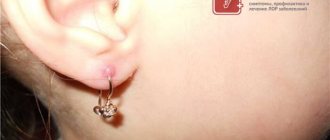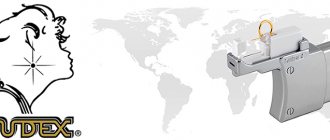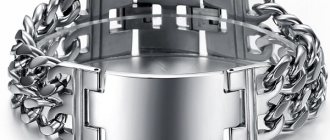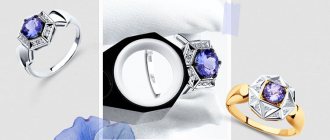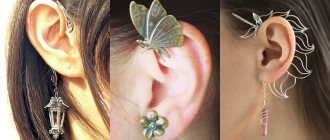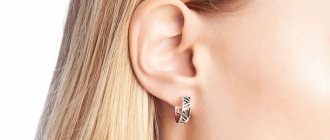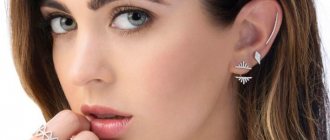Plan
- Types of ear cartilage piercings
- Which earring to choose?
- Stages of the procedure.
- What to do before piercing?
- Contraindications
- How does the process work?
- Caring for your piercing after the procedure
- What tools are used?
- How many days does it take to heal?
- Possible complications after piercing
- What problems might arise and why?
- Recommendations
- Range
- What's in fashion?
The history of ear cartilage piercing goes back centuries: before, every element of the image had meaning, now stylish hoop earrings are a beautiful, spectacular element of a holistic image. To obtain the result, a puncture is performed with a special instrument.
Interestingly, ear piercing is one of the oldest forms of body modification. This was done long before our era, which is confirmed by archaeological research. In the twentieth century, there was a real “boom” in piercing - regarding the piercing of the lobe, it was done by friends at each other’s homes. Gradually, this procedure is turning into a separate service from a medical specialist.
Cartilaginous piercing differs significantly from earlobe piercing - both in the procedure, the instruments used, the care, and the healing process. This type of puncture is painful and sometimes requires pain relief.
Types of ear cartilage piercings
- Helix is a type of piercing where the upper part of the shell at the helix is pierced, partially capturing the cartilage. The peculiarity of the procedure is that it is quite painless, since there are no nerve endings there.
You cannot select jewelry that is thick - if the earlobe stretches (for example, under tunnels), then the cartilage does not.
- Forward Helix is also a piercing of the cartilage part, but in the opposite place from the previous type. Usually several punctures are made here for miniature jewelry.
It should be taken into account that healing, in this case, is a long process - about 4 months.
- Industrial piercing is a type of puncture of the cartilage part, which requires 2 holes on the upper cartilage, with a barbell earring inserted between them. The most popular option: one hole in the front of the sink, near the head, the second - exactly at the opposite point.
Initially, it is not recommended to insert a steel earring; wear bioplastic jewelry for several months while the healing process takes place.
- Days piercing - a puncture is supposed to be made in one of the curls of the internal cartilage, performed from top to bottom. You can install half rings, rings, rods of a certain type. Sometimes several punctures are made. This type is universally suitable for both sexes.
After the puncture, the earring is immediately inserted; it should not be too thick so as not to cause discomfort. The healing process, depending on various factors, can last up to 8 months.
- Ruuk piercing is a puncture in the cartilage of the ear opposite the tragus on the protrusion. It is more difficult if the ear concha is naturally small, but this is not a limitation if this is the type of piercing you want. This is difficult only for the master. You also need to carefully and carefully select jewelry - not everything will suit. Consider your anatomical features and consult a professional.
- Orbital piercing is a type of double puncture. The peculiarity is that the ini connect the ring. The number of punctures may vary, but the procedure is not performed at once - it is carried out in stages so as not to cause discomfort and complications. Healing lasts up to 1 year.
The specialist does not just pierce, but before that he carefully calculates the distance between the holes, taking into account possible changes in the cartilage itself.
- Tragus piercing is a tragus piercing, the most elegant option, considered for women. A puncture is expected in the front of the shell. Miniature rings and carnations are suitable for it.
Immediately after the procedure, you need to be careful - do not sleep on the side of the puncture, and it is not advisable to use an earphone.
Which earring to choose?
Initially, before piercing, decide on the thickness of the earring, since the hole in the cartilage does not stretch, as is the case with the earlobe.
- One of the most popular options is a barbell or barbell. The optimal solution for industrial punctures. Visually, it is a tube with clamps; it does not bend. The decor is varied - stones, thorns and other decorations.
- The ring is the standard type of earring for both cartilage and lobe. The circle is not closed; in place of the missing part there is an insert-ball or other decor.
- Labret is a decorated stick similar to a stud. The straight stick is bordered by discs on each edge.
- A circular is a horseshoe that ends with balls on both edges.
- Banana is an earring of a characteristic shape, with a twist on both ends - a ball or a cone.
Types of Piercing Earrings
- A barbell is one of the popular types of jewelry. Another name is Barella, it is suitable for this type of ear piercing, such as industrial. The product is a straight, rigid tube with clamps at the ends. Manufacturers offer a wide selection of decor in different shapes, you can put a chain on it.
- Labret is a straight stick with decor or a disk on both sides, looks like a stud. The product is installed from the inside and outside.
- A ring is a circle with a part missing. A ball or decorative element is installed in this place.
- Banana is a spiral earring with a twist on both sides in the form of cones and balls. Stone inserts are widely used.
- Circular - in the shape of a horseshoe, on both sides of which balls are wound.
- Fang - decoration for the lobe. A curved cone is installed in the tunnel, it serves to stretch the hole.
Stages of the piercing procedure
- If there are no contraindications for the procedure, the specialist carries out training: the specialist examines the features of the ear; disinfecting the ear with alcohol; The puncture site is marked with a special marker. Some puncture sites are much more painful than others. Pain medication may be used.
- Fixation with a tool - using a clamp.
- The cartilage is manually pierced with a catheter needle - the needle is removed, leaving the catheter.
- Next, the previously disinfected jewelry is inserted into the catheter, and it is gradually pushed out by the earring.
- As a result, the catheter is removed from the stem and the ball is screwed onto the earring.
Preparing for the piercing procedure
The puncture site is first examined by a specialist to assess the location of the vessels and the anatomical features of the ear.
The main point is that piercing the ear cartilage is painful, more difficult than piercing the earlobe. Before piercing, start with the lobe.
- First, the entire ear is disinfected - it is treated with 95% alcohol.
- The jewelry itself, which will be inserted immediately after the puncture, is disinfected: for this purpose, treatment is carried out in an autoclave (dry heat), which allows you to kill 99.9% of microbes. The disinfection process takes 15-30 minutes.
- A dot is placed at the puncture site with a special antiseptic marker, and anesthesia is administered.
Since the procedure is quite painful, local anesthesia is used: external, injection, or both. A special cream or spray is applied to the skin as an anesthetic, then an injection is given. Sometimes only external anesthesia is enough - it all depends on the puncture site and the client’s pain threshold.
Types of piercings with photos
There are the following types of ear cartilage punctures:
- Industrial. This is the name of a type of piercing that combines 2 punctures. They are done in the area of the upper part of the ear curl. You can combine 2 points with the help of a long barbell earring.
- Tragus. The master pierces the tragus of the ear. Most often, this piercing is combined with small rings.
- Antitragus. The specialist makes a hole in the cartilage that is located opposite the tragus. This method is not suitable for everyone, because... Often there is not enough space to place the piercing.
- Days. The master processes the cartilage directly above the ear opening. This is a painful procedure, due to which you will have to part with your headphones for a long time. In Russia, such piercings on ear cartilage are rare.
- Snug. It is accompanied by a puncture of the upper part of the antihelix. The procedure is painful, so anesthesia is used first.
- Conc. Piercing involves the use of rings or wide hoops.
- Hand. Another name for ear piercing is “Rook”. An angular puncture is made on a thick fold of cartilage in the area of the lower pedicle. This is the most painful type of piercing. Such a wound takes longer to heal.
Industrial is a type of ear piercing that combines two holes.
Contraindications
There are a number of features that do not allow ear cartilage piercing - primarily to protect against complex and dangerous consequences.
First of all, you cannot perform the puncture yourself, anywhere; it is dangerous to trust the procedure to just anyone - the process can have irreparable consequences if something is done incorrectly. Contact the professionals!
Before the procedure, the master pays attention to the anatomical and physiological features of the client’s ear. Sterile operating conditions are extremely important.
In some cases, a professional, a licensed master, will refuse to carry out the procedure. Grounds for refusal:
- Any blood disease;
- Pregnancy;
- The client has not reached the age of majority;
- Traumatic brain injury;
- The client has diabetes;
- Rheumatism, arthritis;
- The client came in sick (flu, ARVI).
When is cartilage piercing prohibited?
Alas, in this case there are also little things, the observance of which is simply necessary. To be more precise, there are prohibitions on piercing the ear cartilage. And very often it happens that people have absolutely no idea about this, go to get a cartilage piercing and end up with a lot of health problems. And sometimes they know about problems, but completely ignore them. If you want everything to be in order with your ear and overall health, you should not pierce the ear cartilage in certain cases:
Traumatic brain injuries that have not yet healed are an important prohibition against performing a puncture.
If you have inflammatory ear diseases, you should also avoid wearing earrings.
Allergy reactions, which can wake up at any moment, can also become an obstacle.
Piercing the ear cartilage is also prohibited for various disorders directly related to the psyche.
Damaged skin in the area of the ear concha also prohibits ear piercing.
If a person has a fever or is in a serious condition associated with fever, it is strictly forbidden to make a puncture with a gun or catheter; the method does not matter here.
If suddenly a pregnant woman decides to pierce the cartilage in her ear, she should first visit a doctor and consult with him about this. If a child wants to have their ear pierced, under no circumstances should a medical needle be used at an early age. At first, only a pistol is allowed, and then, when the child becomes a teenager or turns over 18 years old, it is allowed to use a catheter.
How does the process work?
The cartilage is specially illuminated with a lamp to determine the anatomical features and location of the vessels. Then preparatory work is carried out - disinfecting the ear with alcohol, placing a dot at the puncture site. To obtain a hole, a catheter needle of the required thickness is used. The earring is immediately inserted into the puncture.
There is no need to fear for your vision, hearing or other body functions. There is a stereotype that piercing carries a danger of damaging nerve endings. Large nerve branches cannot be damaged, so there is no need to fear for your health. Especially if you trust a professional.
Advantages and disadvantages of a needle
Experienced professionals believe that a needle is better for piercing than a gun. The procedure is carried out using sterile materials.
The puncture is quite simple:
- marking;
- treating the skin with a disinfectant composition;
- preparing a sterile needle (the package is opened in front of the client);
- performing a puncture;
- an earring is inserted into the needle and inserted into the hole;
- tool disposal.
If you look at what the puncture site looks like after using a needle and a gun, the question of what is better to pierce your ears, nose or navel disappears. The wound after the needle looks neat because the tip of the instrument is sharp. The needle pierces the skin quickly and accurately. Thanks to the professional work of the master, pain during the procedure is practically not felt. The advantage is the sterility of the instrument. The needle is suitable for piercing any part of the body.
The disadvantages include the terrifying appearance of the instrument. When the needle is hidden in the gun, you don't pay attention to it.
Caring for your piercing after the procedure
Healing after a cartilage piercing takes longer than with an earlobe piercing. To ensure that the process goes without any problems or complications, it is recommended to follow these recommendations:
- You should not touch the puncture site - this is important, since it is quite easy to get an infection.
- Healing occurs over the course of 4 weeks - those earrings that were inserted immediately after the piercing do not need to be removed during this time.
- For a certain time, baths and saunas are prohibited, for the same reason as in the first paragraph. For the first three days after the procedure, you should generally be extremely careful with water procedures. A categorical ban on swimming in natural bodies of water.
- You cannot move or twist the earring installed after the piercing - the more you irritate the puncture area, the more the fibrous tissue thickens.
- Prohibition of hot baths and showers - high-temperature water can cause bleeding.
- Be careful not to catch the piercing with hair or clothing.
- It is not recommended to sleep on the side in which the piercing was made - a person may twist in his sleep, and you will not notice how you injure the puncture area.
- The main point is that alcohol should not be used as an antiseptic, as it can cause tissue burns.
For quick healing and care, experts recommend special products, taking into account the type of piercing.
For the first 4 weeks, you need to regularly treat the puncture with an antiseptic - only in this case can and should you rotate the earring. This is necessary so that the product is evenly distributed throughout the channel, entry and exit points of the earring - everything must be thoroughly disinfected.
If you play sports, after taking a shower, you need to additionally treat the hole with an antiseptic.
If the puncture site, with proper care, becomes red, swollen, or painful, you should contact the specialist who performed the puncture as soon as possible.
Normal puncture healing
Normally, healing takes 6 months. In the first 1-2 weeks, severe swelling persists. It reaches its peak 2-4 days after the procedure. The thickness of the ear in the treatment area can increase 2-3 times. There is no reason to worry: this is the body’s natural reaction to damage. The swelling will gradually decrease. If at this time the swelling is greater than expected, and the jewelry begins to press into the soft tissues, the earring is replaced free of charge.
Sometimes hematomas and redness appear near the puncture site in the first days. This may be a variant of the norm. You should contact a specialist or a doctor if a lump appears soon after the procedure or change of jewelry. The cause of concern should be soft red bumps that cause discomfort when touched. An increase in the size of the tubercle, discharge of pus and an increase in temperature are signs of infection.
The puncture can be called completely healed when the redness around it disappears.
What tools are used?
In terms of the set of tools, ear cartilage piercing differs from earlobe piercing. The lobe is pierced with a special gun or needle. The hole can stretch, depending on the diameter of the decoration - there is no need to carefully select the diameter.
There are a little more problems with cartilage:
- Since it does not stretch, you must initially select the number of a special needle for a specific size.
- For a puncture, a catheter needle of a certain number is used - it indicates the size of the future hole.
- A window clamp, a clamp and a special ring release are also used.
The main tasks of the specialist who performs the piercing are to avoid two problems:
- Crushing of ear cartilage.
- Getting injured due to incorrect actions.
To avoid problems and injuries, piercing is performed manually with a needle, since the gun can crush the cartilage.
Reviews on ear cartilage piercing
Yulia Borisova, Moscow
I asked the master how long it would take for the cartilage to heal after an ear piercing and he told me that my case was standard and everything would happen in 6 or a maximum of 10 weeks. Unfortunately, I had to get rid of the ring much earlier. Despite the treatment, purulent discharge began, the entire ear turned red and became very sensitive, the temperature rose repeatedly, a seal appeared in the puncture area and the cartilage became swollen. An infection occurred and treatment was required.
Angela Milova, Kazan
Hello everyone, I was faced with the fact that my ear was swollen after a cartilage puncture; it was impossible to sleep on the side of the wound. I didn’t contact the specialist who did the piercing and relied on my own strength. I read on the Internet about how to treat such inflammation at home and did everything according to the instructions. As a result, it only got worse and my ear even turned blue. As soon as I pulled out the labret on my own, all the negative symptoms disappeared. I don’t advise anyone to get a cartilage puncture, it hurts.
Ksenia Agapova, Ekaterinburg
Everyone asks if it hurts to pierce the ear cartilage, and I answer that it doesn’t hurt at all, since you need the right attitude for this operation. I personally have a beautiful piercing. At first there was a slight swelling and slight redness, and sensitivity increased. There was a small cloudy discharge. This is the norm. I only took care that the escaping serous exudate and lymph did not form a crust. After a month and a half of processing, I happily showed off my new jewelry.
Anastasia Menshova, Nizhny Novgorod
I was lucky because I found a good tattoo and piercing artist. He believes that piercing the ear cartilage with a pistol is unacceptable, since it creates an unsightly ragged edge of the hole, it cannot be sterilized and there is a risk of infection. It is also important that when working with this tool you cannot control the intensity of the impact, so it is easy to cause injury. I had my cartilage punctured with a catheter and I am very happy. I didn’t notice any side effects, except for a little discomfort.
Days style piercing, ring with decoration 3 labrets with spikes in the cartilage and 3 rings in the earlobe tragus piercing - tragus piercing, small barbell (or labret) with a ball
Today, there are rough men's cartilage earrings on sale. They help enhance the effect of the tough and brutal appearance of the stronger sex. The exact opposite of such jewelry is delicate women's earrings, which help to increase attractiveness and add charm. For those who are not satisfied with standard solutions, we offer an unusual piercing with a shocking design, which can often be seen on the most daring celebrities.
Possible complications
During the piercing process, the following problems are possible: crushing of the ear cartilage, injury, infection. What does this mean?
- Using a gun can crush the cartilage, so the piercing is performed with a sterile catheter needle.
- If crushing occurs, the cartilage may die and take a long time to heal.
- Even if healing occurs, scars and large holes that do not heal are possible. To avoid necrosis, you need not only to contact a professional, but also to regularly treat the puncture site.
- Another risk is associated with allergic reactions - this is not a common problem, but it is worth noting that the body may have an adverse reaction to some metals. It is recommended to use medical or jewelry style titanium as the first earring.
Care for fast healing
Healing of cartilage can last several months and directly depends on compliance with the processing rules. In order for the wound to heal quickly, it is necessary to care for it throughout the entire rehabilitation period.
Care:
- Do not get it wet in the first few days.
- Do not remove the earring until it is completely healed.
- Twice a day and after exposure to dust and dirt, treat the hole with antiseptics: Chlorhexidine, medical alcohol, Miramistin, hydrogen peroxide 3%.
- Wipe the puncture site with an additional antiseptic after sports activities.
- Starting from the second day, pull the jewelry so that the canal can heal properly and the earring does not adhere to the skin. In the first days this is difficult to do, as the hole may swell.
If the wound becomes very painful or festers, seek medical help. An infectious process may develop.
If you are allergic to the alloy from which the product is made, removal and replacement with a hypoallergenic material may be recommended.
What problems might arise and why?
First of all, the most dangerous factor is dirt, microbes, and mechanical damage. Contact with any dirty objects, microcracks can cause blood poisoning, purulent processes, and bleeding.
If you have had viral diseases (especially shortly before piercing), otitis media, or upper respiratory tract diseases, this may negatively affect the regeneration processes, and the healing process will take longer.
Constant mechanical influences and scars are a consequence of improper care. If you notice a slight deviation from the norm, immediately contact a specialist to understand the cause of the problem. In some cases, not only ordinary care is required, but also therapy with more serious methods.
The most common problem is inflammation. Causes:
- The earring is constantly removed, forgetting that this cannot be done for 4 weeks;
- Swimming in a river or lake is a sure step to introduce dirt and microorganisms into an unhealed puncture;
- Do not regularly treat the puncture site;
- The procedure was carried out incorrectly and by a non-professional.
Scarring, purulent inflammation, lumps, abscesses, compactions are signs not only of low hygiene, but also of low immunity and previous infectious diseases. In rare cases, rejection is, on the contrary, a sign of a high level of immunity.
If any abnormal sign appears, you should immediately contact a specialist. You may need medication to help you recover quickly.
Piercing technique
Before puncturing the cartilage, the puncture site is wiped with medical alcohol, and the earring is treated with Miramistin or Octenisept.
The puncture point is marked with a marker, the ear is fixed, and the cartilage tissue is pierced with a medical needle, on the other side of which there is a catheter with an earring already inserted into it. The needle is removed once the earring is fully seated in the cartilage. The procedure itself is quick, however, discomfort remains after it.
Some salons use a gun instead of a piercing needle. We won’t talk in too much detail about how ears are pierced with a gun, but let’s say that this procedure is similar to the procedure for piercing an ear with a needle.
A needle is inserted into the gun, just like into a catheter, then the tip of the needle is pointed at the point marked with a marker and the “trigger” is pulled.
However, in reality, a qualified craftsman will not do this because it is dangerous. The reason for the danger lies in the fact that the gun cannot be completely sterilized, as a result of which quite serious infections can get into the wound.
In addition, the gun often leaves "ragged" edges of the hole. What makes the situation worse is that cartilage tissue is quite fragile. When using a gun, you can not only severely damage the cartilage, but also practically crush it.
Recently, new pistols have appeared that minimize the risk of serious damage. Regarding whether it hurts to pierce the ears with a gun, we can say that this procedure is considered almost painless, because the puncture occurs much faster than when using a needle, and the person does not have time to feel the pain.
Recommendations
- There is no need to start piercing your ears with cartilage; first, try experimenting with the lobe - the procedure is less painful and heals quickly (up to 1.5 months).
- Do you want some punctures? There is no need to do several operations at once - this is a painful process.
- It is imperative to carefully care for the puncture itself, especially during the first year.
- Don’t forget that cartilage takes longer to heal and the procedure itself is painful.
- Tell your doctor right away if you are allergic to certain metals. It is advisable to find out if you have allergies before the procedure.
- Maintain hygiene - treat the hole 2-4 times a day, always after a shower or sports activities.
- Wear your headphones carefully; it is better to use wireless ones.
- Before processing the canal and the edges of the hole, be sure to thoroughly wash your hands and treat them with an antiseptic. A saline solution is suitable for treating the canal.
How long will it take for cartilage to heal?
Actually, after a person has experienced for himself whether it hurts to pierce the cartilage in the ear, he is interested in healing and caring for it. If an ordinary lobe heals quickly enough, it will take about a month to restore the hole in the cartilage. Earrings on the cartilage should not be removed during this time, but constantly moving and scrolling it is allowed and even useful. This is necessary to do in order to develop the ear piercing and prevent the hole from overgrowing.
We have already decided how long it will take for the punctured cartilage to heal. Now we need to talk about his care and care. To prevent infection from forming on the cartilage, it is imperative to use special antiseptics. For example, this is Levomekol - a special ointment that helps recovery after a puncture. In addition, the use of hydrogen peroxide or Baneocin is allowed - a special powder that will also have an extremely positive effect. You need to monitor the puncture carefully, treat it with care and treat it twice a day with peroxide, ointment or powder, while simultaneously rolling the earring inside the hole, because the product must penetrate directly into the territory of the canal itself. As for alcohol, its use is strictly prohibited; it can only have a negative effect on a pierced ear in the cartilage area. During the first three days, it is strictly forbidden to visit open reservoirs and swimming pools, as well as baths. After you have taken a shower or taken a bath in your home, you need to further treat the cartilage on your ear, which is so delicate and needs care.
If you suddenly notice that the ear is noticeably red, certain discharge is coming out of the pierced area, inflammation is visible, or something similar that cannot be attributed to normal healing, you urgently need to seek help from a doctor. He will tell you exactly what is wrong with the ear cartilage and how to get rid of such problems.
Range
Freak Boutique offers high-quality and stylish earrings for ear cartilage piercing - made of steel, titanium, brass, with or without stones.
- Ring made of surgical steel with a minimalist cross - without unnecessary decoration or stones. The material is safe for humans, does not cause irritation, and is not subject to corrosion. Ring thickness – 1.6 mm.
Surgical or jewelry steel is popular in jewelry making because it is quite durable, hypoallergenic, relatively inexpensive, and hygienic. The surface has no pores, so harmful microbes can only be on the surface, and it can be easily disinfected. The necessary properties of the alloy are given by its components - nickel, molybdenum, chromium.
- Ring with a diameter of 8 mm made of black surgical steel with a flat insert. Easy to secure using a release mechanism.
- Ring with a release mechanism made of surgical steel. Thin – thickness 1.2 mm, diameter – 8 mm. The main feature is the presence of an insert with white opal. The stone shimmers with blue and pink highlights.
A similar option is a ring with an amethyst. On the miniature insert is a light purple stone. The diameter is slightly larger than the previous version - 1 cm.
- Titanium ring 1.2 mm thick for ear cartilage. The highlight is a rounded insert with an opal of a rich, bright blue color.
Titanium is considered the metal of the future, due to its properties, it is more often used for jewelry because it is: relatively inexpensive, durable, looks beautiful, lightweight, hypoallergenic.
- Ring made of surgical steel with a ball-shaped insert. Anodized metal gets an unusual look - the surface is multi-colored, iridescent. The diameter of the product is 1.1 cm.
A similar option - without a ball insert, a regular smooth titanium ring.
- Clicker ring made of high quality 925 sterling silver, expandable type. Recommended for the nose, but also suitable for the ear.
The labret is made of titanium – a durable, hypoallergenic metal. Suitable for punctures at different points of the ear cartilage. The main highlight is the decoration with opal stone (turquoise, pink, lilac-white, blue-green). The fixation labret is equipped with an internal thread.
Labrets made of jewelry or surgical steel without stones are an excellent option as a first piece of jewelry. Several size options available.
Circulars are often used for both the septum and the ears. This horseshoe model is made of surgical steel, in black color. At the ends there are cones-spikes.
Industrial bars are one of the most spectacular decorations, especially for punk and cyberpunk styles. A wide selection of bar inserts are available, which serve as decoration: with symbols, with stone inserts, with a chain. There are also removable barbell decorations.
Procedure and complexity of the puncture
Before the piercing procedure, you need to familiarize yourself with the important rules for its implementation, and also make sure that there are no contraindications.
Helix (ear piercing in the upper area of the arch) is contraindicated in the following cases:
- skin diseases (acute and chronic);
- cuts, scratches, damage to the skin;
- acute respiratory diseases and inflammatory processes of the middle ear;
- allergic reaction to metals;
- cardiovascular diseases;
- hypertonic disease;
- peptic ulcer of the gastrointestinal tract;
- benign formations;
- diabetes;
- mental disorders;
- diseases associated with blood clotting disorders;
- renal failure;
- pregnancy and lactation period.
Before starting the procedure, you must select the jewelry that will be installed for initial wear. Before the procedure, the master must place the jewelry in a container with a disinfection solution.
Piercing jewelry provided in the salon is sterile and stored in individual packaging. Often such jewelry is made of surgical steel, titanium or bioplastic. These materials are hypoallergenic, have a smooth surface and optimal dimensions to promote rapid wound healing.
The sequence of piercing the ear using a catheter:
- The puncture site is treated with a disinfectant solution.
- A mark is placed on the auricle with a special marker.
- The ear is fixed with a special clamp with a window opening.
- The master pierces the ear with a catheter, maintaining a certain angle to form the correct location of the channel.
- The needle is removed and only the catheter is left in the hole.
- In order to insert the jewelry, the labret rod is inserted into the catheter tube and, using light pressure, it is gradually advanced, pushing out the catheter.
- The specialist gives recommendations on caring for the wound surface of the puncture.
Another, faster method, but which brings more discomfort during healing, is puncture with a gun.
Helix (ear piercing accompanied by damage to cartilage) is pierced with a disposable stud earring. The surface of the ear is treated with a disinfectant solution, and the earring removed from the sterile packaging is inserted into the gun. A mark is placed on the pinna and a quick puncture is made.
Disadvantages of piercing cartilage with a gun:
- The earring used for the puncture has a small diameter, so it will be impossible to install jewelry with a larger diameter, since the cartilage tissue does not stretch.
- Piercing jewelry is short in length, so if there is swelling, the earring may put pressure on the tissue, which can significantly complicate the healing process.
- When punctured with a gun, the cartilage tissue can be crushed, which will lead to tissue swelling and a long recovery period.


